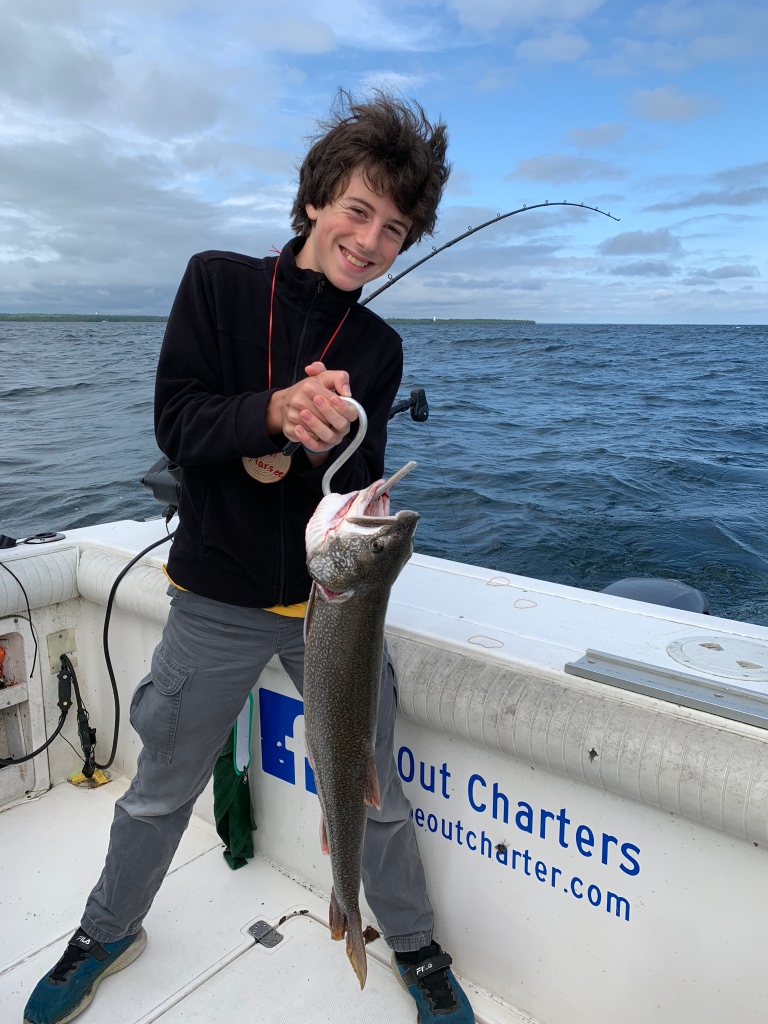By Evan Marsee
This special guest post comes from Evan Marsee, 13-year-old son of Michigan Sea Grant’s graphic designer, Todd Marsee. Thank you for sharing your experience with Freshwater Feasts!

Last week — from August 4th to August 10th — while I was at the Great Lakes & Natural Resources 4-H Camp near Rogers City, there were charter fishing activities for first-year campers. Each day, a different cabin group went out onto Lake Huron (more specifically, by Presque Isle Point) by six in the morning. Although we had to wake up at around 5:00 A.M., daybreak is evidently one of the best times to go fishing. The boys from my cabin went with Brandon Schroeder, a Sea Grant extension agent who taught fisheries activities at camp, and a fisherman named Rick, onto his small fishing boat.
We were lucky that there were only two-foot waves during our trip, but our small fishing boat still rocked intensely and a couple people got sick because the watercraft was moving quickly, bouncing on the waves. Eventually, Rick slowed the boat down, set up the fishing poles and weights that were attached to the side of the vessel, and we waited. Each person caught their fish in turn, and if the fisherman found something tugging the line, a kid would come up to the pole, reel it in, and hold it up for Brandon to take a picture.
As a slightly disappointing result of the 4½ hours spent on the water, the two boats together caught seven fish. There were four collected from the larger one, which the girls from our group fished on, and three from the smaller one that I and a few other boys went on. I was not able to catch any fish, although I may have been able to if we stayed longer. However, Brandon let me hold another kid’s catch.

Here, with a background of Lake Huron and the Presque Isle area, I am holding the 28-inch, 7-pound trout on the charter fishing boat. Photo: Brandon Schroeder
All seven of the fish were lake trout, and the sizes were all between 10 and 28 inches, as Rick and Brandon estimated. The heaviest (the 28-incher) weighed in at approximately 7 pounds. In the time we used to try to catch the fish, we stayed in water between 55 and 135 feet deep. The girls’ boat seemed to stay a bit shallower, and while we looped down the coast and back, they stayed close to Presque Isle Point.
I filled out a sheet about the fish, taking note of some important statistics for each trout. Sometimes I would use the dashboard in the covered front of the boat for finding the water temperature when we caught the fish (this was mostly around 68 degrees Fahrenheit) and depth hooked (between 100 and 120 feet below the surface). I felt sorry for the fish because I could often hear them flapping around in the ice-cooled tank we put them in, bleeding into the little water that was in there.

A photo of me on Rick’s boat, holding the notepad. This was before we caught any fish, but there I was checking fishing/boating conditions on the top half of the sheet. Photo: Brandon Schroeder
At 10:30 A.M. we headed back, since we had already spent a long time out on the water and needed to get back by 11 or so. When we gathered in front of the camp’s Fletcher Hall before lunchtime, everyone that caught a fish would hold it by the gill and often be pressured to kiss it (although it wasn’t mandatory). One of the kids didn’t want to hold their fish, so I got to pick it up instead. The trout was extremely slimy and easy to slip out of my hand, so I gripped it and joined the others.
Our afternoon activity was Fish Processing, in which we would cut filets of the fish we caught. Aside from this, we had to put the fish’s stomach in a bag to send to the DNR of Michigan to see what the fish had been eating. I worked with another girl from my cabin group, using her 26-inch lake trout. She dissected and fileted the fish the way Brandon had shown us before. Being squeamish, I did not touch any part of the trout much, although I did help out by reminding her where to cut in which spots. (Luckily there wasn’t too much blood all over the place.) When we were done, we put its slightly squashed stomach in a Ziploc bag and the slabs of meat from its sides in another.

Every day before lunch, first-years from the assigned lake groups showed their catch. On Wednesday, the team managed to get a sea lamprey, and one boy held the still-living parasite up from behind its mouth (and even kissed it). Friday’s catch was, unfortunately, just one — the only steelhead of the week. They had caught others, but apparently they either got away or, in one’s case, were just over the size limit (so they wanted to let it grow more).
On Friday afternoon, Brandon and the camp cooks prepared the main course of the night’s meal, from all fileted fish. Some of the campers helped with this as well, working with the cooks in their self-selected afternoon activity. However, because I chose to do a Wild Edibles session, I did not get to experience this.

At dinnertime, in line for getting food, I saw a sour-cream-slathered section of chunks of the fillet, a nacho- cheese-style group, and a just-breaded section. I took one piece of the first two listed types. With that, as well as the sides and dessert of the meal, I was full but satisfied. Overall, though I did not catch any fish, charter fishing on Lake Huron — and the fish-related activities that followed — were neat experiences.
